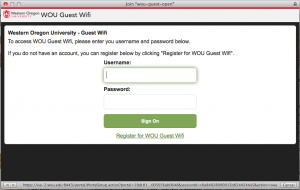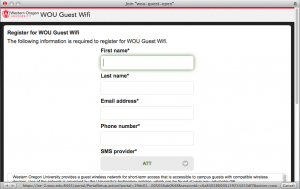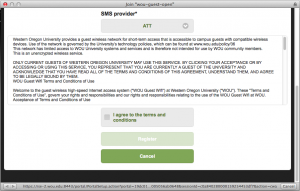Where to start…? Maybe a summary from the ten thousand foot level, then expand out from there, yet keep a rein on going too far into details. 🙂
Summary:
WOU supports a variety of computer labs, smart classrooms, faculty and staff workstations and residential computing. A variety of software packages are supported, both in computer labs, virtually and on faculty/staff workstations. High speed internet is provided to campus as well as the residence halls through both wired and wireless connections. NERO is our internet provider. There is both a primary and redundant data center. The network infrastructure includes routing, switching, firewalls, intrusion detection, network access control, wireless access points, etc. A variety of enterprise applications are supported, including purchased, open source and developed.
Detail:
There are 25+ computer labs in a variety of locations on campus. This includes Hamersly Library, APSC, Education, DeVolder Family Science Center, Natural Science, Creative Arts and Werner University Center, along with many others. There are approximately 400 lab stations available for students. This includes a mixture of PC’s, Mac’s and VDI (virtual) stations. VDI can also be accessed remotely by a resident hall student from their own computer, providing access to a variety of software titles. There are 40 Xerox 8870 color cube computers spread across all of these labs.
The lab workstations contain a variety of software including the Adobe Creative Suite, MS Office, Google Apps, SPSS, ARC GIS, Autodesk suite, Matlab, SAS, MSDN, Sophos and many others. Not all applications are found at all locations. All the applications contained on VDI, can be accessed remotely from anywhere, utilizing your WOU Pawprint account credentials.
There are 110 smart classrooms on campus. Every room has one or two installed video projectors. The instructor station has a computer, document camera, touch panel control system, AV interface, Blu-Ray DVD play and a sound system. In addition some rooms contain an annotating or touch screen monitor, lecture capture system and IP-video conferencing. Some of the larger rooms are dual-platform, PC, Mac or VDI. Several lab-classrooms include the ability to display any of the lab stations on the projection screen. About 20 of the classrooms have Apple-TV capability, giving you the ability to display the contents of an iOS device on the projection screen.
There are approximately 800 faculty and staff workstations on campus. The current workstation life cycle is four years. There is a combination of PC’s, Mac’s and VDI stations, depending on need. Access to Google Apps and MS-Office is provided on each station. Other software is provided on an as-need basis. In addition there are approximately 200 general-use stations.
The network backbone is a switched 10 Gb/sec network. Network from the core to a building is typically two 10Gb/sec network ports that are aggregated, effectively providing 20 Gb/sec of bandwidth, plus redundancy. In most cases, there is 1 Gb/s to the desktop. The connection from WOU to the internet is a 500 Mb/sec connection. NERO provides WOU internet services. There is a redundant core project under way. Both the campus and residence halls has wireless connectivity provided through 600 Cisco wireless access points, centrally managed by redundant wireless lan controllers.
The data center includes UPS power, backed up by a diesel generator. The core server infrastructure resides on Cisco UCS Blade servers. NetApp is our primary storage vendor, while SuperMicro provides secondary storage. The data center includes both traditional spinning hard drives and solid-state drives. The majority of the servers are virtualized. There are 100 plus servers installed in the virtualized environment, including Windows Server 2008, 2012, RedHat, Oracle Linux and OpenIndiana. More information on the redundant data center can be found here.
Examples of enterprise software run in the data center include, DNS, DHCP, Moodle course management system, Astra course and event scheduling, HVAC control system, Dimensional Data Warehouse, Portal, Oracle Enterprise Database, Oracle ODI, Cognos Connection and Framework manager, wouTV and many more.
Digital Media Productions resources include a studio with LED lighting, a TriCaster, 4 Sony HD video cameras, a Mac Pro editing station running Final Cut Pro X. DMP broadcast its’ projects on the local community cable channel and wouTV as well as campus digital signage.






